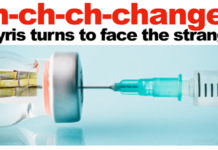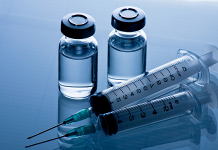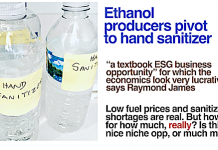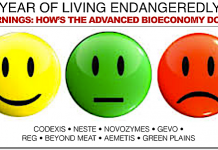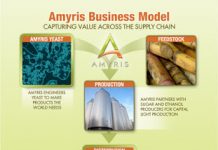Jim Lane 
Amyris was dismissed by the critics some time ago, but is ately continuing a big comeback.
We have become so accustomed to receiving obituaries of Amyris (AMRS) that recently I was inspired to re-read the Devotions of John Donne to discover if, in fact, he wrote, “Send not to know for Whom the Bell Tolls, it Tolls for Amyris.”
Amyris, we were recently assured by short-sellers, was as dead as a doornail, just as Jacob Marley was reputed to be in the opening stave of A Christmas Carol and it is therefore enough to startle the angels when the quarterly earnings roll in and we read that not only is Amyris alive and well, sales are up 177% for Q3 (compared to Q3 2013), the company is expanding to a second molecule, and expects “cash payback on its Brotas plant” by 2016.
It is tempting to see the story of Amyris as one of unexpected redemption, a rescue from Hades effected by the miraculous intervention of Olympian gods, as if Orpheus had gone down to the underworld and rescued biobased farnesane from certain oblivion.
But it probably is more of a mundane case of Chicken Littles amongst industry observers the plant was not ready for prime-time when first launched, a gigantic learning curve was embarked on in the harsh light of public company reporting, and what we are seeing is success delayed, rather than the deliverance of a soul from the underworld. Turns out that Chicken Little, in looking at the 10-Ks and declaring that the sky was falling in, was wrong yet again.
Now, if the company spent a considerable amount of time in the penalty box, that it understood this market in these times is always happy to whack a technology stock that mistimes the forward projection of its arrival at break-even. There is little doubt that the Amyrisians up in Emeryville would like to have arrived in 2012 where they are today, and that they have been chopped up in the public markets for running the trains late and running the trains on time, as we might recall, even propped up Mussolini’s reputation for a number of years. It is a virtue never to be discounted.
But there is indeed good news from Planet Amyris, and we are delighted to see it.
The New Molecule
On the molecule front, Amyris is now selling, via its global distributor network, a second renewable ingredient under its Neossance brand. Neossance Hemisqualane is a pure, plant-derived, light emollient with high spreadability and proven performance characteristics. Amyris touts that “this ingredient addresses the mid-price emollient market with better performance and competitive pricing compared to existing products in this large and growing market.”
Chief Business Officer Zanna McFerson adds: “Building on the success of our Neossance Squalane product, and after positive reaction from more than fifty customers who sampled our new hemisqualane product, we are expanding our Neossance portfolio of ingredients with another high performance solution for the cosmetics industry.”
What is hemisqualane, again?
If you have not quite yet mastered hemidemisemi, er, hemisqualane you might not have memorized exactly what an emollient is, either, unless you have been spending more time with QVC or the Home Shopping Channel than might be good for you. An emollient is a moisturizing skin cream that softens and relaxes.
Back in the days when I was gainfully working at ELLE magazine, we would have regarded the arrival of a new, high-performing emollient right before Christmas as evidence that Santa Claus exists and that no hope for a year-end bonus is too outrageous as long as it is grounded in the desire of people to have youthful-looking skin well past the age of 115.
Amyris adds:
“Neossance Hemisqualane is a natural alternative to petroleum-based paraffins and silicone ingredients. Neossance emollients offer many high-performance properties that make them ideal ingredients across beauty categories including skin, hair, sun care, makeup and cleansing.
“In skin care, hemisqualane’s great sensorial profile and high spreadability create elegant and light textures with a non-tacky, non-greasy and smooth finish. Hemisqualane has a soft and silky after-feel with the ability to maintain a persistent emollience on the skin, making it a superior ingredient for many skin care products. In addition, its ability to dissolve crystalline UV filters makes it an ideal ingredient for sun care products.
“In makeup, hemisqualane facilitates a smooth and even application for lipsticks and foundations due to its high spreadability. It also demonstrates excellent cleansing properties for makeup removal applications including for waterproof formulations like mascara.
“For hair care, hemisqualane has good slip and a soft after-feel, which are critical attributes for products like conditioners and styling products.
Not surprisingly, Amyris touts: “We are very encouraged by the early response and demand we are experiencing from some of the leading brands in Japan, the Americas and Europe.”
Face vs fuel
Now, we’ve written much about food vs. fuel who hasn’t? But there’s been less written about “face vs fuel” which is to say, why are companies like Amyris that were supposed to make jet fuels and diesels on the road to massive impact on bottom line and society, making emollients?
Keep in mind that squalane is a hydrocarbon, and a terpene and if you visited ABLC Net this past week you would have received quite an earful regarding the bridge between flavorings, fragrances and high-performance fuels that exists in the world of terpenes. There must be more than 50,000 of them in nature and when you are delighted by the fresh scent of Ponderosa Pine as you trek through California’s natural wonderlands, you are in fact getting a whiff of terpenes. They are advantaged hydrocarbons, as well, when it comes to super-dense fuels and farnesane, which is Amyris’ primary pivot point, is already a source of fuels via its partnership with Total and we may well see some large-scale production of same before the end of the decade.
But for now, Amyris is all about generating business, and as most of us holiday shoppers have observed, fragrances are selling at just a teency bit of a premium over diesel. Like $100 for 3.5 ounces, vs $3.50 a gallon.
The financials
Accordingly, as Amyris ramps up production, the operating results of the company have a tremendous focus on the chemicals side.
Cowen & Company’s Jeff Osborne writes:
“Amyris reported strong operational improvements in 3Q. Product revenue of $11.5 mn was up 177% y/y due to strong fragrance strains; however jet fuel sales appear to be ramping slowly due to regulatory delays. The company now expects to be cash flow positive in 2015 versus late 2014, due to a change in collaboration inflows. Brotas appears to be running well and cash cost is targeted at below $3/L.
He added: “Amyris introduced a new farnesene strain at the Brotas refinery during the quarter, which should allow sub-$3/L production costs. We were pleased to see the company transition from making high ASP fragrance oil to farnesene without any issues or elongated downtime. The plant has run smoothly for 3 months, which should allay some investor fears after an up down initial 15 months out of the gates.”
Looking forward, Cowen & Co expects:
“About $30 million of renewable product sales in 2014 and a doubling of that in 2015, with a cadence of $10 mn per qtr in 1H15 and $20 mn per quarter in 2H15, as 6 new molecules ramp. Management reiterated that Brotas will have reached a cash payback by early 2016 as the company focuses on maintaining a total cash gross margin structure over 60%
Osborne warns:
“We are keen to see how the company handles marketing 1 molecule in 1H14 to 2 currently to 8 by the end of next year. (aided by an ASP of ~$10/L with gross costs below $3/L).
Over at Raymond James, the always quotable Pavel Molchanov writes:
“After a period of retooling while in the “overpromise and underdeliver” penalty box, 2013-2014 have been Amyris’ first years with operations truly in commercial mode. There is visible scale-up progress, but the historical reliance on partner-based R&D payments makes quarterly financials choppy. In addition to updates on the production ramp-up at the Brotas plant, the market wants to see additional clarity on the pace at which Total will be scaling up its fuels joint venture with Amyris. We maintain our Market Perform rating.
Molchanov highlights that expectations were “on” for Amyris to reach break-even in late 2014 on a cash basis:
“The clear-cut aim was for cash flow to finally turn positive in 2H14. Following 3Q’s cash burn, the updated timeline is for this milestone to be reached not right away but rather on a full-year basis in 2015. Lower near-term collaboration inflows are the main culprit for the pushout.
He adds: “It’s worth noting that Amyris is deliberately running Brotas to avoid complications, particularly after the painful experience of 2011-2012. Margins are emphasized over volumes, and, as such, our model projects late 2015/early 2016 for achieving full nameplate capacity at Brotas.”
On the recent downturn of stocks in the sector: “The stock has, of course, shown weakness amid the oil price selloff – as have essentially all other companies in the broad category of petroleum substitutes. As a sentiment trade, it’s understandable, but as a practical matter, there is virtually no linkage between the prices of oil and farnesene/squalane. The current focus for Amyris – and plenty of others in the bioindustrial space – is high-value materials rather than commodity fuels, and until Amyris establishes a meaningful footprint in the fuel market – unlikely until 2017 at the earliest – the direct read-through from oil prices for production economics is minimal.”
The Bottom Line
A new molecule, pushed out financials but nothing that deters analysts from predicting imminent turn to cash-positive in 2015, and an outlook that pushes on into larger-volume products later in the decade, including fuels: that’s the welcome news from Amyris.
Turns out that the company was not as dead as once broadly thought but rather something of a late bloomer, and that’s not always a bad thing as Ronald Reagan’s many admirers will recall that he only entered elective politics at age 55. He said something else that might be well re-purposed to a discussion of the Advanced Bioeconomy: “You and I have a rendezvous with destiny. We will preserve for our children this, the last best hope of man on earth, or we will sentence them to take the first step into a thousand years of darkness. If we fail, at least let our children and our children’s children say of us we justified our brief moment here. We did all that could be done.”
Jim Lane is editor and publisher of Biofuels Digest where this article was originally published. Biofuels Digest is the most widely read Biofuels daily read by 14,000+ organizations. Subscribe here.

